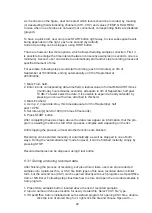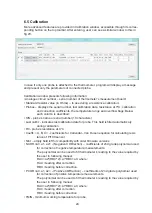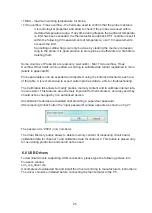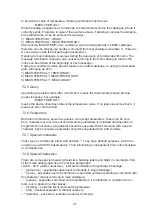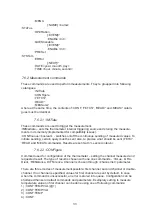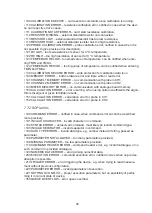
34
To measure temperature on second channel:
1) :CONF:TEMP:VAL (@2)
2) :CONF:TEMP (@2)
3) :CONF (@2)
Measurement of gradient or resistance, requires providing full path of commands. To mea-
sure gradient on first channel, configure using one of following commands:
1) :CONF:TEMP:GRAD (@1)
2) :CONF:TEMP:GRAD.
Measurement of Pt100 probe’s resistance for both channels can be setup using:
:CONF:TEMP:RES (@1,2)
Measurement of temperature difference between channels 2 and 1 can be setup using:
:CONF:TEMP:DIFF (@2,1)
7.6.2.3 :CONFigure?
This command can be used to read thermometer’s current configuration. It returns a string,
formatted with the same structure, as the one used for configuration. For example, if ther
-
mometer is configured to read temperature value of first channel, returned string will be:
TEMP:VAL (@1)
and for resistance measurement on second channel:
TEMP:RES (@2).
Sending this command after connecting to thermometer, allows orientation on which pro-
bes are connected to the device.
7.6.2.4 Result readout commands :FETCh? and :READ?
These commands read the result of currently configured measurement. :FETC? reads the
last result stored in thermometer’s memory, :READ? starts the measurement and then
sends back the result. :READ? can be treated as a sequence of following commands:
1) :INIT
2) :FETC?
Both commands need proper configuration of measurement first. It can be set using
:CONFigure or :MEASure command. For FETC? command, exemplary valid execution can
consist of following sequence:
1) :CONF:TEMP:VAL (@1)
2) :INIT
3) FETC?
For :READ? command:
1) :CONF:TEMP:VAL (@1)
2) :READ?
Commands above must not be called directly one after another. They just need to be called
between last reset of the device, and using the read commands. In such way, no error is
notified.
Calling read commands without any parameters or sub-commands, results in sending
values according to last configuration. It is also possible to read another parameters of the
same measurement. While measuring the temperature of certain channel, probe’s gradient
and resistance can also be read. During double-channel measurement, each parameter’s
value can be achieved.
Read command must be called in order to do that, including specific sub-commands and
list of channels, similarily as in :CONFigure command. While tempting to read an unmea
-
sured value, error is notified.
Measurement result is sent back after filling the sample buffers, which can take up maxi
-
mum of 25 seconds. Because non-holding mode of command execution is used, during
this time the thermometer won’t react to any other commands.
Summary of Contents for LDT 2000
Page 1: ...1 LDT 2000 PRECISION THERMOMETER MANUAL...
Page 14: ...14 5 Typical performance of the thermometer...
Page 15: ...15...
Page 16: ...16...
Page 17: ...17...
Page 43: ......
Page 44: ......



